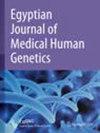Identification of circRNA–miRNA–mRNA regulatory network associated to the autism spectrum disorder in children through integrated bioinformatics analysis
IF 1.2
Q4 GENETICS & HEREDITY
引用次数: 0
Abstract
Autism spectrum disorder (ASD) is a complex neurological disability with multifactorial etiology. ASD is described by behavior, speech, language, and communication defects. CircRNA is a type of ceRNA that plays an important role in modulating microRNAs (miRNA) in several disorders. However, the potential role of the circRNA/miRNA/mRNA regulatory network in the pathogenesis of ASD is not fully understood. Therefore, this study aimed to create a circRNA/miRNA/mRNA network associated with ASD to cast light on the pathogenesis of ASD. CircRNA expression profile data were recruited from Gene Expression Omnibus datasets, and the differentially expressed circRNAs (DEcircRNAs) were identified. Then, miRNAs modulated by these circRNAs were predicted and overlapped with differentially expressed miRNAs. Next, the potentially involved genes were identified by overlapping predicted targets, and differentially expressed genes. The enrichment analysis was performed, and a PPI network was projected. Subsequently, ten key genes were selected from the network. Furthermore, a circRNA/miRNA/mRNA regulatory network was constructed, and probable molecules and drugs with potential anti-ASD effects were predicted. 11 DEcircRNAs and 8 miRNAs regulated by 4 circRNAs were identified as being significantly involved. Subsequently, gene enrichment analysis of 71 overlapped mRNA regulated by these miRNAs showed that they are mostly associated with hippocampal synaptogenesis, neurogenesis, and axon guidance. Additionally, two high-score compounds, GSK3β inhibitor (SB216763) and dexamethasone, and three drugs (haloperidol, nystatin, paroxetine) were confirmed as potential therapeutic options for ASD. The results of this study may help gain deeper insight into the pathogenesis of the circRNA/miRNA/mRNA regulatory network in ASD, providing potential therapeutic management options.通过综合生物信息学分析确定与儿童自闭症谱系障碍相关的 circRNA-miRNA-mRNA 调控网络
自闭症谱系障碍(ASD)是一种复杂的神经系统残疾,具有多种病因。自闭症表现为行为、言语、语言和交流缺陷。CircRNA 是一种 ceRNA,在调节多种疾病中的微RNA(miRNA)方面发挥着重要作用。然而,circRNA/miRNA/mRNA调控网络在ASD发病机制中的潜在作用尚不完全清楚。因此,本研究旨在建立一个与ASD相关的circRNA/miRNA/mRNA网络,以揭示ASD的发病机制。研究人员从基因表达总库(Gene Expression Omnibus)数据集中收集了循环RNA表达谱数据,并鉴定了差异表达的循环RNA(DEcircRNAs)。然后,预测受这些 circRNAs 调节的 miRNAs,并将其与差异表达的 miRNAs 重叠。接下来,通过重叠的预测靶点和差异表达基因确定可能涉及的基因。进行了富集分析,并推算出了一个 PPI 网络。随后,从网络中选出了十个关键基因。此外,还构建了一个 circRNA/miRNA/mRNA调控网络,并预测了可能具有潜在抗 ASD 作用的分子和药物。11个DEcircRNA和8个受4个circRNA调控的miRNA被确定为显著参与其中。随后,对这些miRNA调控的71个重叠mRNA进行的基因富集分析表明,它们大多与海马突触发生、神经发生和轴突导向有关。此外,两种高分化合物(GSK3β抑制剂(SB216763)和地塞米松)和三种药物(氟哌啶醇、尼司他丁和帕罗西汀)被证实为治疗ASD的潜在选择。这项研究的结果有助于深入了解 ASD 中 circRNA/miRNA/mRNA 调控网络的发病机制,从而提供潜在的治疗方案。
本文章由计算机程序翻译,如有差异,请以英文原文为准。
求助全文
约1分钟内获得全文
求助全文
来源期刊

Egyptian Journal of Medical Human Genetics
Medicine-Genetics (clinical)
CiteScore
2.20
自引率
7.70%
发文量
150
审稿时长
18 weeks
 求助内容:
求助内容: 应助结果提醒方式:
应助结果提醒方式:


